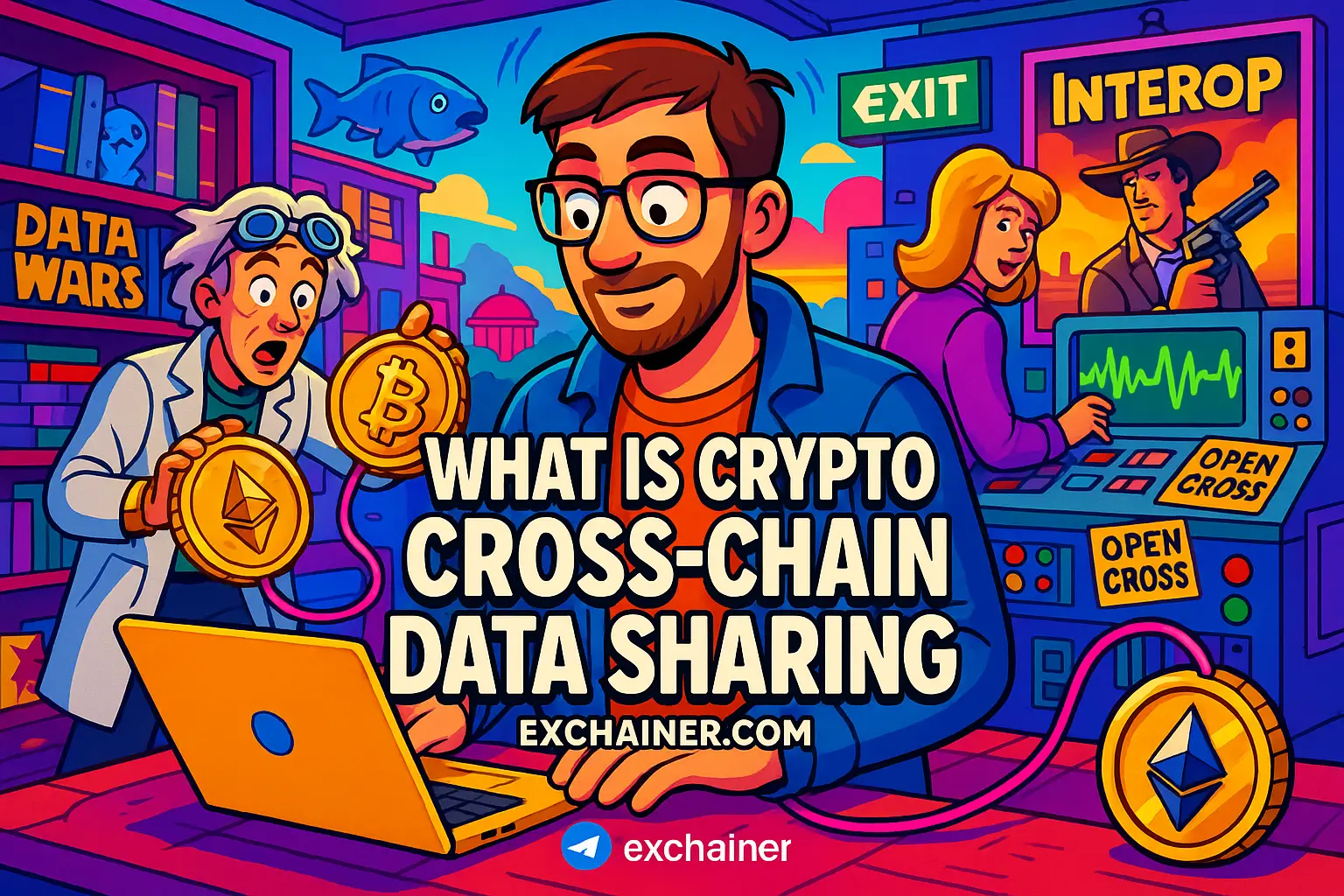Introduction
Friends, if you’ve been keeping an eye on the crypto scene, you’ve probably noticed how the blockchain world is expanding fast — not just in terms of projects but in how they interact. The rise of DeFi (decentralized finance) and multichain ecosystems means we’re no longer dealing with isolated chains. This rapid growth creates a huge need for crypto cross-chain data sharing, enabling blockchains to talk and exchange information seamlessly.
So, what is crypto cross-chain data sharing? Simply put, it’s the technology and processes that allow different blockchain networks to share data — not just tokens or assets but the information stored on their ledgers — in a secure, verifiable, and efficient manner. This capability is a game-changer because it breaks down silos, letting applications and users access a wider ecosystem without being stuck on just one chain.
In this article, we’ll dive into how cross-chain data sharing works, explore the main protocols making it happen, discuss security concerns and how they’re addressed, and highlight real-world use cases that show why cross-chain interoperability is vital for the blockchain future. Whether you’re a developer looking to build interoperable apps, an investor curious about where blockchain tech is headed, or just a crypto enthusiast wanting to understand new trends, you’ll find practical insights and best practices here.
By the end, you’ll be equipped to understand and navigate the complex world of cross-chain data sharing confidently. Ready to unravel how different blockchains can share information like old friends swapping stories? Let’s dive in!
What is Cross-Chain Interoperability?
Clear definition and scope
When we talk about cross-chain interoperability, many jump straight to the idea of moving tokens between chains — and that’s one important piece. But it’s critical to separate the concepts: while cross-chain token transfers deal with moving assets such as Bitcoin or Ethereum to another chain, crypto cross-chain data sharing goes deeper. It covers the exchange of information like transaction states, event logs, proofs, oracles data, and smart contract outputs across blockchains.
Think of it like this: transferring tokens is like sending money, while data sharing is like passing along the detailed invoice, receipt, or contract info that shows what the money was for, so both parties can verify and interact reliably.
On-chain vs. off-chain data in cross-chain flows
Cross-chain data sharing involves two broad categories: on-chain data and off-chain data. On-chain data means information stored *within* the blockchain itself — things like transaction hashes, block confirmations, events triggered by smart contracts, and state commitments. For example, if a decentralized exchange completes a trade, the transaction details recorded on its chain can be shared with another blockchain to confirm and react accordingly.
Off-chain data, on the other hand, includes information coming from external sources or oracles. This could be price feeds from real-world markets, weather data for insurance contracts, or other APIs that blockchains alone don’t produce. Off-chain data is critical because many blockchain applications rely on information outside their networks for decision-making. Effective cross-chain data sharing must accommodate both types seamlessly.
Finality, proof, and data lineage
A key challenge in cross-chain data sharing is trust — how does one chain know that data from another chain is genuine, not tampered with, and final? This is where concepts like finality, proof, and data lineage come in. Finality means a transaction or block is confirmed and irreversible within a blockchain, often after a certain number of confirmations or consensus checkpoints.
To confirm data authenticity across chains, cryptographic proofs such as Merkle proofs or transaction receipts are used. These are like digital fingerprints that prove a specific piece of data belongs to a particular block without revealing the entire block’s content. Maintaining data lineage — the history and origin of data — helps chains validate that the information comes from a legitimate source and hasn’t been altered during transmission.
Key Protocols, Bridges & Middleware
Core technical patterns
Crypto cross-chain data sharing relies on several technical patterns that enable secure and reliable interactions between blockchains. One popular pattern is Hash Time-Locked Contracts (HTLCs), which allow conditional asset exchanges between chains using cryptographic hashes and time constraints. They’re widely used for atomic swaps but can also facilitate basic data verification steps.
Relayers are off-chain entities that watch events on one chain and submit proofs or transactions to another — acting as bridges for data and tokens. Light clients are simplified versions of blockchain nodes that validate block headers and proofs without storing full chains, enabling direct verification across different chains.
State proofs are cryptographic proofs of a blockchain’s current state or specific data points, allowing a recipient chain to trust the data without fully trusting the sender. Each pattern has trade-offs between complexity, security, and speed, depending on the use case.
Notable protocols and projects (quick comparisons)
Several projects are leading the cross-chain data sharing revolution, each with its own approach:
Cosmos IBC (Inter-Blockchain Communication) provides a standardized protocol for blockchains in the Cosmos ecosystem to exchange data and tokens securely. It focuses on modularity and decentralized control.
Polkadot’s XCM (Cross-Consensus Messaging)</b enables parachains within Polkadot’s relay chain to send messages and data in a trust-minimized way, facilitating complex cross-chain workflows.
LayerZero and Hyperlane</b are relatively new protocols aiming to create lightweight, general-purpose interoperability layers connecting multiple blockchains with a focus on scalability and security.
Wormhole</b is one of the earliest bridge projects supporting cross-chain token transfers and messaging between networks like Solana, Ethereum, and Binance Smart Chain, although it faced some security challenges along the way.
Each has design trade-offs, from decentralization and trust models to speed and the types of data supported.
Role of oracles and middleware in data sharing
While protocols handle blockchain-to-blockchain communication, oracles play a crucial role in bringing off-chain data into the ecosystem. Projects like Chainlink and Band Protocol gather real-world data and submit it securely to smart contracts. In cross-chain data sharing, oracles can also act as middleware, enriching messages with external data for more complex applications.
Middleware solutions abstract underlying blockchain differences, providing developers easier ways to integrate multiple chains, handle message queues, and manage data reliability. They help make cross-chain data sharing more accessible beyond hardcore blockchain experts.
Security Challenges & Mitigations
Common attack vectors and failures
Cross-chain data sharing introduces new security risks beyond single chains. Bridges, which often act as data gateways, have been primary targets for attackers. High-profile exploits have drained hundreds of millions by exploiting vulnerabilities in bridge smart contracts or trusted relayers.
Compromised relayers or oracles can feed incorrect data, triggering false states on receiving chains. Replay attacks where the same message is submitted multiple times also threaten consistency. Different consensus mechanisms across blockchains add complexity, making it harder to verify finality or order data.
Technical mitigations and security models
To combat these risks, projects implement fraud proofs — where invalid data submissions can be challenged and reversed — and optimistic or zero-knowledge security models ensuring only correct data passes through.
Threshold signatures and Multi-Party Computation (MPC) techniques spread trust among multiple parties to avoid single points of failure. Light-client verification enables chains to independently verify state proofs without fully trusting intermediaries.
Operational safeguards: audits, monitoring, insurance
Security isn’t just technical; operational best practices are essential. Independent third-party audits catch vulnerabilities early. Continuous monitoring detects suspicious activities and triggers alerts. Multisignature governance controls prevent rogue actions by single administrators.
Insurance pools and bug bounty programs protect users and incentivize good security hygiene. Adopting these safeguards is a must for any project aiming to handle cross-chain data sharing at scale.
Real-World Use Cases & Examples
DeFi composability and asset routing
Cross-chain data sharing unlocks powerful DeFi opportunities. It enables aggregated liquidity across chains, where users can swap assets or borrow funds seamlessly from multiple blockchains. Cross-chain Automated Market Makers (AMMs) tap data from various sources to adjust prices and balances effectively.
Multi-chain yield farming strategies leverage shared data to optimize returns on different protocols, increasing capital efficiency. As a result, traders and liquidity providers no longer have to be limited by a single chain’s ecosystem.
NFTs, gaming, and identity data flows
Non-fungible tokens (NFTs) benefit from cross-chain data sharing in ways like confirming provenance or ownership history across networks. Gaming projects use it to maintain a shared game state or achievements accessible regardless of the underlying chain.
Identity data sharing allows users to port verified credentials between dApps, creating portable, decentralized IDs. These cross-chain flows improve user experience and open new possibilities for social and financial applications.
Enterprise and data-sharing applications
Beyond consumer use, enterprises use cross-chain data sharing to enhance supply chain transparency by exchanging verified records across multiple ledgers. Cross-ledger settlements reduce friction in cross-border payments.
Consortium blockchains operate in environments where different organizations run separate chains but need to exchange trusted business data securely and privately, a perfect case for cross-chain data protocols.
Standards, Best Practices & Future Trends
Emerging standards and specifications
Just like HTTP standardized web communication, the blockchain world needs unified standards. IBC pioneered this approach by defining interoperable data packet formats and handshake protocols. Other initiatives focus on interchain SDKs and common data schemas to harmonize event structures and state proofs.
Standardization reduces complexity, streamlines development, and enables a richer ecosystem where chains can "plug and play" with minimal friction.
Developer best practices for secure data sharing
For devs building cross-chain solutions, some core design principles improve security and reliability: minimize the amount of trust in any single party or oracle; design clear failure and rollback modes; implement retries and idempotent message handling to avoid double processing.
Utilizing testnets and simulation environments that mirror multichain scenarios helps uncover integration issues early, saving headaches post-launch.
Future trends to watch
Looking ahead, trendsetters are creating data availability layers separate from execution for better scalability. Modular blockchain stacks let chains specialize and compose functionality more easily.
Rollups combined with hub-and-spoke architectures will enhance data and message throughput, while composable cross-chain primitives empower developers to design complex multi-chain logic with reusable building blocks. The future is cross-chain, indeed.
Conclusion
To wrap things up, crypto cross-chain data sharing is the key to unlocking blockchain’s full potential. It makes sending tokens just the tip of the iceberg and opens up a world where chains collaborate by exchanging rich sets of data securely and efficiently. The main protocols like Cosmos IBC, Polkadot XCM, and new interoperability layers provide different flavors of implementation, each balancing trust, speed, and complexity.
However, as recent bridge exploits remind us, security challenges cannot be ignored. Employing a mix of cryptographic proofs, robust governance, audits, and insurance is essential to protect users and networks. The payoff is immense — from enabling complex DeFi strategies, NFT provenance, game data synchronization, to enterprise data sharing across multiple ledgers.
For builders and decision-makers diving into this space, here’s a quick checklist: choose protocols fitting your needs, prioritize thorough security approaches, and adhere to emerging data standards to ensure future compatibility and ease of integration.
As more projects embrace cross-chain data sharing, we’ll witness greater blockchain interoperability, fueling DeFi growth and real-world applications at scale. This technology promises to make the fragmented blockchain world a truly connected ecosystem.
Curious to learn more and start exploring? Check out the beginner-friendly guides in our Crypto 101 category. If you want to choose the right exchange or platform that supports multichain assets, visit our Exchange Reviews. And to manage your digital assets securely as you interact across chains, explore handy tools and wallets in our Tools and Wallets section.
For further reading, authoritative sources like CoinMarketCap’s glossary on cross-chain and official project websites provide great insights. Stay curious and keep learning — the blockchain universe is vast and just getting started!
Internal Links:
Crypto 101
Exchange Reviews
Tools and Wallets
External Links:
CoinMarketCap: Cross-Chain Explanation
Cosmos IBC Official Site












